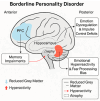Understanding the Borderline Brain: A Review of Neurobiological Findings in Borderline Personality Disorder (BPD)
- PMID: 40722851
- PMCID: PMC12292566
- DOI: 10.3390/biomedicines13071783
Understanding the Borderline Brain: A Review of Neurobiological Findings in Borderline Personality Disorder (BPD)
Abstract
Borderline personality disorder (BPD) is a complex and heterogeneous condition characterized by emotional instability, impulsivity, and impaired regulation of interpersonal relationships. This narrative review integrates findings from recent neuroimaging, neurochemical, and treatment studies to identify core neurobiological mechanisms and highlight translational potential. Evidence from 112 studies published up to 2025 is synthesized, encompassing structural MRI, resting-state and task-based functional MRI, EEG, PET, and emerging machine learning applications. Consistent disruptions are observed across the prefrontal-amygdala circuitry, the default mode network (DMN), and mentalization-related regions. BPD shows a dominant and stable pattern of hyperconnectivity in the precuneus. Transdiagnostic comparisons with PTSD and cocaine use disorder (CUD) suggest partial overlap in DMN dysregulation, though BPD-specific traits emerge in network topology. Machine learning models achieve a classification accuracy of 70-88% and may support the tracking of early treatment responses. Longitudinal fMRI studies indicate that psychodynamic therapy facilitates the progressive normalization of dorsal anterior cingulate cortex (dACC) activity and reductions in alexithymia. We discuss the role of phenotypic heterogeneity (internalizing versus externalizing profiles), the potential of neuromodulation guided by biomarkers, and the need for standardized imaging protocols. Limitations include small sample sizes, a lack of effective connectivity analyses, and minimal multicenter cohort representation. Future research should focus on constructing multimodal biomarker panels that integrate functional connectivity, epigenetics, and computational phenotyping. This review supports the use of a precision psychiatry approach for BPD by aligning neuroscience with scalable clinical tools.
Keywords: biomarkers; borderline personality disorder; default mode network; fMRI; functional connectivity; machine learning; psychodynamic therapy; transdiagnostic.
Conflict of interest statement
The authors declare no conflicts of interest. AI was used as a tool to help streamline the structuring of tables and summaries during the review process and enhance the language level.
Figures





References
-
- American Psychiatric Association . Diagnostic and Statistical Manual of Mental Disorders. 5th ed. American Psychiatric Publishing; Arlington, VA, USA: 2013.
-
- Grant B.F., Chou S.P., Goldstein R.B., Huang B., Stinson F.S., Saha T.D., Smith S.M., Dawson D.A., Pulay A.J., Pickering R.P., et al. Prevalence, correlates, disability, and comorbidity of DSM-IV borderline personality disorder: Results from the Wave 2 National Epidemiologic Survey on Alcohol and Related Conditions. J. Clin. Psychiatry. 2008;69:533–545. doi: 10.4088/JCP.v69n0404. - DOI - PMC - PubMed
-
- Ansell E.B., Sanislow C.A., McGlashan T.H., Grilo C.M. Psychosocial impairment and treatment utilization by patients with borderline personality disorder. Psychiatry Serv. 2007;58:821–827. - PubMed
Publication types
LinkOut - more resources
Full Text Sources

